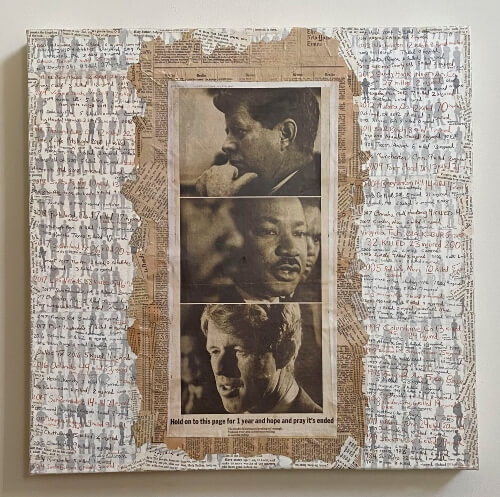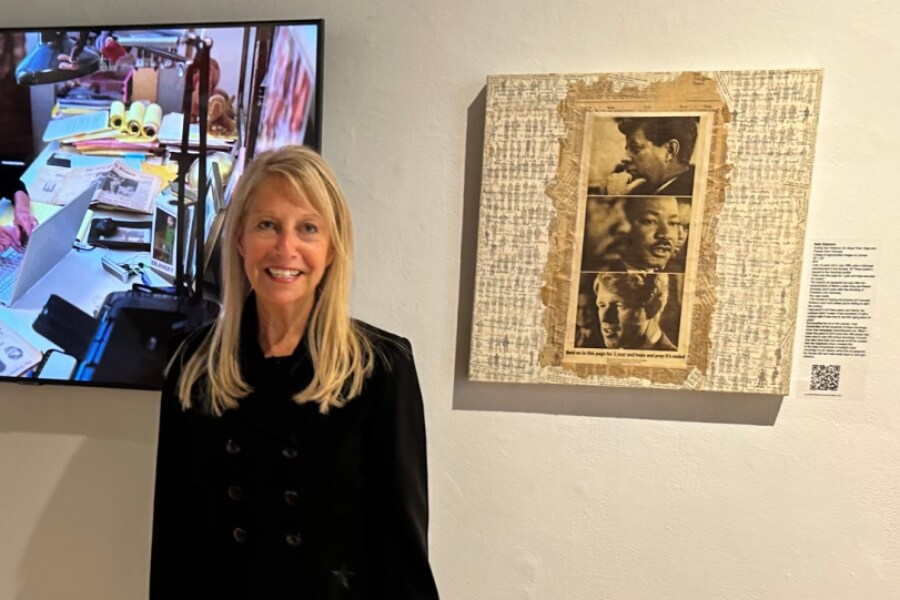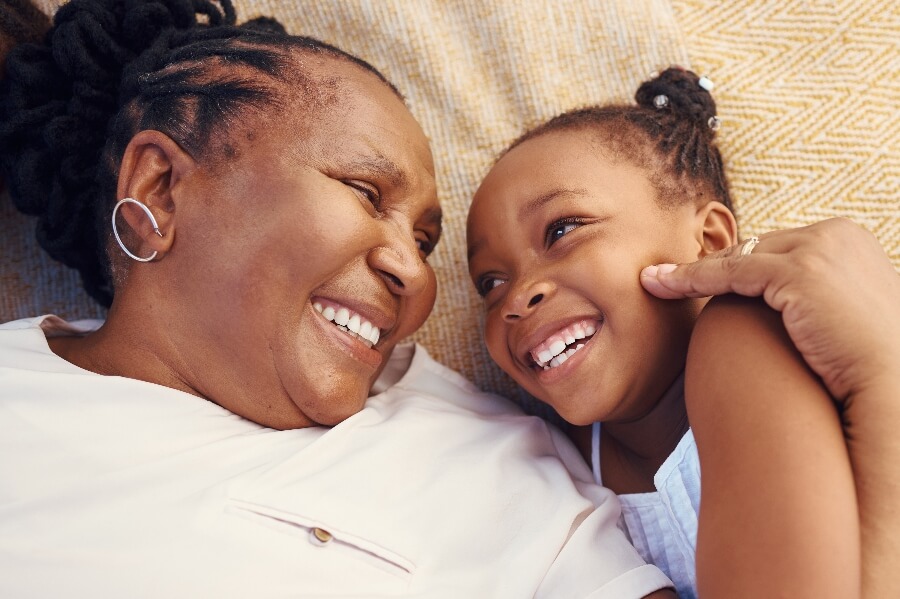I was 14 years old in July 1969 when I saw a startling full-page ad in the Sunday New York Times pleading for an end to gun violence. It asked the reader to hold onto the page for a year and hope and pray the violence would end. I had saved it for over half a century, biding my time knowing as an artist I would use in some way. As the gun violence in our country kept multiplying, the need to create an art piece chronicling all the hundreds of mass shootings in the U.S. over the past four decades felt urgent. Incorporating this vintage ad seemed essential.
That this collage entitled, “Ending Gun Violence—It’s About Time—Hope and Prayers Aren’t Enough” is now part of an exhibit in Highland Park, Illinois, a town that became a victim of gun violence 53 years since that ad pleaded for its end, is particularly poignant.
This July 4th this close-knit town outside Chicago observed the one-year anniversary of a tragic mass shooting at their Independence Day parade. That fateful morning last year, 15 minutes into the parade. seven people were killed and 48 wounded by bullets fired from a semi-automatic rifle.
Read More: Not Again! Nicole Hockley Talks about Preventing More School Shootings
Gun Violence: A Devastating Anniversary
A week before that somber one-year observance, I had the honor of spending time in this vibrant town filled with tree-lined streets and tranquil beauty, for the opening of the art show at the Art Center of Highland Park where I was the featured artist.
For me, Highland Park became more than another tragic statistic in our seemingly never-ending list of mass shootings.
A safe, idyllic American town forever changed, became for me so much more than another tragic statistic in our seemingly never-ending list of mass shootings.
Highland Park could be my town. Its friendly residents could easily be my neighbors. The opening at the Art Center became a place for me to engage in talks about gun violence with the town’s residents and it was clear the aftershocks of the tragic July 4th shooting continue to reverberate.
I could see the pain in the eyes of the people I talked to. Nearly everyone had a story because in this tight community, everyone knew one another. All are on different emotional journeys as they look back. The trauma is deep and very real.
Remembering Another Tragedy

Sally Edelstein’s collage featuring a NYT ad from 1969 that seems to have done little good. Around the ad, Edelstein has written the names of the hundreds of mass shootings since then.
At one point I noticed a family huddled in conversation around my gun violence collage.
I watched as the mother tried to describe the meaning of the collage to her daughter. Walking over, I introduced myself as the artist of the piece and gently explained to the little girl its genesis. Her parents seemed grateful for the help.
At the time, I was not that much older than this little girl named Ashley, who had lived with more gun violence in her short 12 years than I ever had at that age.
Pointing out the centerpiece of the collage, the now yellowed full-page New York Times ad, I told her I was a teenager in junior high school when I first saw this in the newspaper and had kept it all these years. For decades I had taken it with me packed among other saved newspapers from apartment to apartment, house to house. I was not that much older than this little girl named Ashley, who had lived with more gun violence in her short 12 years than I ever had at that age.
The ad appeared one year after the assassinations of Martin Luther King and Robert Kennedy, and six years after the shooting of President John Kennedy. I had been moved by the headline that asked the reader:
” Hold onto this page for 1 year and hope and pray it’s ended.”
“The trouble is hoping and praying isn’t enough,” I read out loud. “Violence won’t end unless you’re willing to start the ending.”
Youthful Enthusiasm Dashed
I explained to her that in the tumultuous spring of 1968, Robert Kennedy was running for president and had reached out to the youth of America to join him in his presidential fight.
Mobilized and energized with the earnestness of a 13-year-old, I responded.
My mother woke me and softly said: “Sally, darling, your friend Bobby Kennedy has been shot.”
Every day after school that spring, my best friend Karen and I rode our Schwinn bicycles to the local Robert Kennedy for President headquarters where we volunteered. Located in an abandoned suburban storefront, I would spend my afternoons and weekends stuffing envelopes, making phone calls, and doing whatever grunt work was needed to help ensure that Bobby would be the 1968 Democratic candidate. To me, Bobby Kennedy represented hope.
But on June 6, 1968, just two months after the assassination of Martin Luther King, a nation was left once more to watch and grieve and wonder after another senseless act of violence robbed us of that hope.
On the early morning of June 5th, 1968, my mother had come into my bedroom and sat on the edge of my bed. She woke me and softly said: “Sally, darling, your friend Bobby Kennedy has been shot.”
There was an odd symmetry. It had been I, only five years earlier who had raced home from grade school to breathlessly announce to my mother that John Kennedy had been shot. Now, it was she telling me as I headed to school that another Kennedy had been assassinated.
I was in disbelief, as the elated sense of hope that had been Bobby suddenly drained away.
Three Fallen Heroes: The Nightmare Hasn’t Ended
A year later I clutched onto this ad with its images of three fallen heroes. I had saved it all these years, and clearly, the violence hadn’t ended. It had escalated. I decided it was time to use this aging piece of paper.
Surrounding the ad on the canvas, I had handwritten all the hundreds of mass shootings since that newspaper advertisement ran. When I made this piece in 2019, I explained to the young girl, more than 400 people had been shot in over 230 school shootings. It would now take more than one canvas to fill the number that has happened since I created this.
Looking into her eyes, I knew the fear of gun violence was part of her day-to-day experience despite living in a protected suburban community. For her, July 4th firecrackers would always carry a terrible memory.
School lockdowns are now as normal as school lunches.
Tentatively she opened up to me about her school lockdowns, describing how she is taught to hide during active shooter drills. School lockdowns are now as normal as school lunches. But because it is normal, it isn’t any less scary.
Like the students in Parkland, Uvalde, Sandy Hook, and countless others, the trauma the children in Highland Park experienced did not end with the last bullet fired on that ghastly day on the parade as it made its way down the picturesque streets.
That’s when it begins.
The unrelenting gunfire pierced many more than those wounded or killed in that tragedy. For others who witnessed the unimaginable carnage but were not physically wounded, you can be certain the shooter pierced their hearts and minds.
Many endured weeks or months of nightmares, anxiety, depression, and hyper-vigilance. A smaller group developed PTSD that can linger for decades. All of them will be changed forever.
Our children have absorbed these shootings, informing them that life is not safe. Thoughts and prayers do not stop gun violence nor do they help trauma victims.
Enough is enough. Let’s start the ending.
Read More: Shoot a Student? What Arming Teachers Really Means





















0 Comments